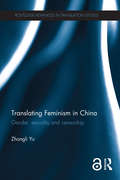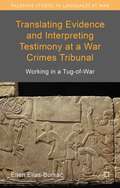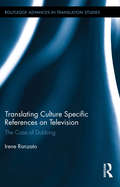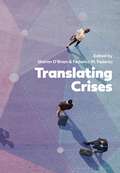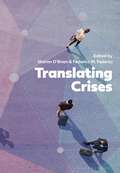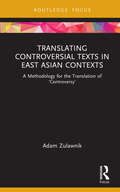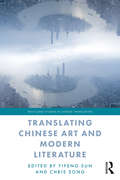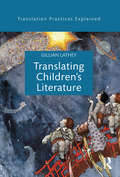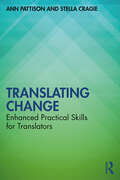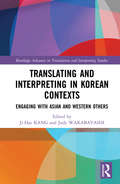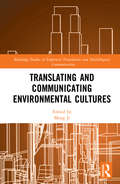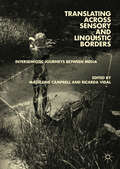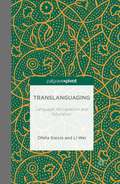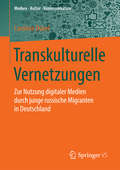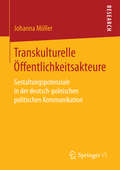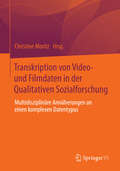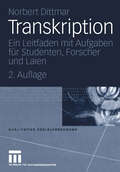- Table View
- List View
Translating Feminism in China: Gender, Sexuality and Censorship (Routledge Advances in Translation and Interpreting Studies)
by Zhongli YuThis book explores translation of feminism in China through examining several Chinese translations of two typical feminist works: The Second Sex (TSS, Beauvoir 1949/1952) and The Vagina Monologues (TVM, Ensler 1998). TSS exposes the cultural construction of woman while TVM reveals the pervasiveness of sexual oppression toward women. The female body and female sexuality (including lesbian sexuality) constitute a challenge to the Chinese translators due to cultural differences and sexuality still being a sensitive topic in China. This book investigates from gender and feminist perspectives, how TSS and TVM have been translated and received in China, with special attention to how the translators meet the challenges. Since translation is the gateway to the reception of feminism, an examination of the translations should reveal the response to feminism of the translator as the first reader and gatekeeper, and how feminism is translated both ideologically and technically in China. The translators’ decisions are discussed within the social, historical, and political contexts. Translating Feminism in China discusses, among other issues: Feminist Translation: Practice, Theory, and Studies Translating the Female Body and Sexuality Translating Lesbianism Censorship, Sexuality, and Translation This book will be relevant to postgraduate students and researchers of translation studies. It will also interest academics interested in feminism, gender studies and Chinese literature and culture. Zhongli Yu is Assistant Professor of Translation Studies at the University of Nottingham Ningbo China (UNNC).
Translating Feminism in China: Gender, Sexuality and Censorship (Routledge Advances in Translation and Interpreting Studies)
by Zhongli YuThis book explores translation of feminism in China through examining several Chinese translations of two typical feminist works: The Second Sex (TSS, Beauvoir 1949/1952) and The Vagina Monologues (TVM, Ensler 1998). TSS exposes the cultural construction of woman while TVM reveals the pervasiveness of sexual oppression toward women. The female body and female sexuality (including lesbian sexuality) constitute a challenge to the Chinese translators due to cultural differences and sexuality still being a sensitive topic in China. This book investigates from gender and feminist perspectives, how TSS and TVM have been translated and received in China, with special attention to how the translators meet the challenges. Since translation is the gateway to the reception of feminism, an examination of the translations should reveal the response to feminism of the translator as the first reader and gatekeeper, and how feminism is translated both ideologically and technically in China. The translators’ decisions are discussed within the social, historical, and political contexts. Translating Feminism in China discusses, among other issues: Feminist Translation: Practice, Theory, and Studies Translating the Female Body and Sexuality Translating Lesbianism Censorship, Sexuality, and Translation This book will be relevant to postgraduate students and researchers of translation studies. It will also interest academics interested in feminism, gender studies and Chinese literature and culture. Zhongli Yu is Assistant Professor of Translation Studies at the University of Nottingham Ningbo China (UNNC).
Translating Evidence and Interpreting Testimony at a War Crimes Tribunal: Working in a Tug-of-War (Palgrave Studies in Languages at War)
by Ellen Elias-BursacHow can defendants be tried if they cannot understand the charges being raised against them? Can a witness testify if the judges and attorneys cannot understand what the witness is saying? Can a judge decide whether to convict or acquit if she or he cannot read the documentary evidence? The very viability of international criminal prosecution and adjudication hinges on the massive amounts of translation and interpreting that are required in order to run these lengthy, complex trials, and the procedures for handling the demands facing language services. This book explores the dynamic courtroom interactions in the International Criminal Tribunal for the Former Yugoslavia in which witnesses testify through an interpreter about translations, attorneys argue through an interpreter about translations and the interpreting, and judges adjudicate on the interpreted testimony and translated evidence.
Translating Culture Specific References on Television: The Case of Dubbing (Routledge Advances in Translation and Interpreting Studies)
by Irene RanzatoTranslating Culture Specific References on Television provides a model for investigating the problems posed by culture specific references in translation, drawing on case studies that explore the translational norms of contemporary Italian dubbing practices. This monograph makes a distinctive contribution to the study of audiovisual translation and culture specific references in its focus on dubbing as opposed to subtitling, and on contemporary television series, rather than cinema. Irene Ranzato’s research involves detailed analysis of three TV series dubbed into Italian, drawing on a corpus of 95 hours that includes nearly 3,000 CSR translations. Ranzato proposes a new taxonomy of strategies for the translation of CSRs and explores the sociocultural, pragmatic and ideological implications of audiovisual translation for the small screen.
Translating Culture Specific References on Television: The Case of Dubbing (Routledge Advances in Translation and Interpreting Studies)
by Irene RanzatoTranslating Culture Specific References on Television provides a model for investigating the problems posed by culture specific references in translation, drawing on case studies that explore the translational norms of contemporary Italian dubbing practices. This monograph makes a distinctive contribution to the study of audiovisual translation and culture specific references in its focus on dubbing as opposed to subtitling, and on contemporary television series, rather than cinema. Irene Ranzato’s research involves detailed analysis of three TV series dubbed into Italian, drawing on a corpus of 95 hours that includes nearly 3,000 CSR translations. Ranzato proposes a new taxonomy of strategies for the translation of CSRs and explores the sociocultural, pragmatic and ideological implications of audiovisual translation for the small screen.
Translating Crises
by Sharon O’Brien and Federico M. FedericiTranslating and interpreting in crises is emotionally and cognitively demanding, with crisis communication in intercultural and multilingual disaster settings relying on a multitude of cross-cultural mediators and ever-emerging new technologies. This volume explores the challenges and demands involved in translating crises and the ways in which people, technologies and organisations look for effective, impactful solutions to the communicative problems.Problematising the major issues, but also providing solutions and recommendations, chapters reflect on and evaluate the role of translation and interpreting in crisis settings. Covering a diverse range of situations from across the globe, such as health emergencies, severe weather events, earthquakes, terrorist attacks, conflicts, and mass migration, this volume analyses practices and investigates the effectiveness of current approaches and communication strategies. The book considers perspectives, from interpreting specialists, educators, emergency doctors, healthcare professionals, psychologists, and members of key NGOs, to reflect the complex and multifaceted nature of crisis communication. Placing an emphasis on lessons learnt and innovative solutions, Translating Crises points the way towards more effective multilingual emergency communication in future crises.
Translating Crises
Translating and interpreting in crises is emotionally and cognitively demanding, with crisis communication in intercultural and multilingual disaster settings relying on a multitude of cross-cultural mediators and ever-emerging new technologies. This volume explores the challenges and demands involved in translating crises and the ways in which people, technologies and organisations look for effective, impactful solutions to the communicative problems.Problematising the major issues, but also providing solutions and recommendations, chapters reflect on and evaluate the role of translation and interpreting in crisis settings. Covering a diverse range of situations from across the globe, such as health emergencies, severe weather events, earthquakes, terrorist attacks, conflicts, and mass migration, this volume analyses practices and investigates the effectiveness of current approaches and communication strategies. The book considers perspectives, from interpreting specialists, educators, emergency doctors, healthcare professionals, psychologists, and members of key NGOs, to reflect the complex and multifaceted nature of crisis communication. Placing an emphasis on lessons learnt and innovative solutions, Translating Crises points the way towards more effective multilingual emergency communication in future crises.
Translating Controversial Texts in East Asian Contexts: A Methodology for the Translation of ‘Controversy’ (Routledge Advances in Translation and Interpreting Studies)
by Adam ZulawnikZulawnik focuses on the broad concept of ‘controversy’ and issues pertaining to the translation of politically and historically controversial texts in East Asia. The research methodology is exemplified through a case study in the form of the author’s translation of the best-selling Japanese graphic novel (manga) Manga Kenkanryū (Hate Hallyu: The Comic) by Sharin Yamano (2005), a work that has been problematised as an attack on South Korean culture and the Korean Wave. Issues analysed and discussed in the research include translation risk, ethics, a detailed methodology for the translation of so-called controversial texts exemplified through numerous thematically divided examples from the translation of the chosen Japanese text, as well as examples from a Korean language equivalent (Manhwa Hyeomillyu – Hate Japanese Wave), and definition and contextualisation of the concept of ‘controversy’. There has been limited research in the field of translation studies, which seeks to exemplify potential pragmatic approaches for the translation of politically-charged texts, particularly in multi-modal texts such as the graphic novel. It is hoped that Zulawnik’s research will serve both as a valuable source when examining South Korea–Japan relations and a theoretical and methodological base for further research and the development of an online augmented translation space with devices specifically suited for the translation of multi-modal texts such as – but not limited to – graphic novels and visual encyclopaedias.
Translating Controversial Texts in East Asian Contexts: A Methodology for the Translation of ‘Controversy’ (Routledge Advances in Translation and Interpreting Studies)
by Adam ZulawnikZulawnik focuses on the broad concept of ‘controversy’ and issues pertaining to the translation of politically and historically controversial texts in East Asia. The research methodology is exemplified through a case study in the form of the author’s translation of the best-selling Japanese graphic novel (manga) Manga Kenkanryū (Hate Hallyu: The Comic) by Sharin Yamano (2005), a work that has been problematised as an attack on South Korean culture and the Korean Wave. Issues analysed and discussed in the research include translation risk, ethics, a detailed methodology for the translation of so-called controversial texts exemplified through numerous thematically divided examples from the translation of the chosen Japanese text, as well as examples from a Korean language equivalent (Manhwa Hyeomillyu – Hate Japanese Wave), and definition and contextualisation of the concept of ‘controversy’. There has been limited research in the field of translation studies, which seeks to exemplify potential pragmatic approaches for the translation of politically-charged texts, particularly in multi-modal texts such as the graphic novel. It is hoped that Zulawnik’s research will serve both as a valuable source when examining South Korea–Japan relations and a theoretical and methodological base for further research and the development of an online augmented translation space with devices specifically suited for the translation of multi-modal texts such as – but not limited to – graphic novels and visual encyclopaedias.
Translating Chinese Art and Modern Literature (Routledge Studies in Chinese Translation)
by Yifeng Sun Chris SongTranslating Chinese Art and Modern Literature examines issues in cross-cultural dialogue in connection with translation and modern Chinese art and literature from interdisciplinary perspectives. This comprises the text-image dialogue in the context of Chinese modernity, and cross-cultural interaction between modern literature in Chinese and other literatures. This edited collection approaches these issues with discrete foci and approaches, and the ten chapters in this volume are to be divided into two distinct parts. The first part highlights the mutual effects between literary texts and visual images in the media of book, painting, and film, and the second part includes contributions by scholars of literary translation.
Translating Chinese Art and Modern Literature (Routledge Studies in Chinese Translation)
by Yifeng Sun Chris SongTranslating Chinese Art and Modern Literature examines issues in cross-cultural dialogue in connection with translation and modern Chinese art and literature from interdisciplinary perspectives. This comprises the text-image dialogue in the context of Chinese modernity, and cross-cultural interaction between modern literature in Chinese and other literatures. This edited collection approaches these issues with discrete foci and approaches, and the ten chapters in this volume are to be divided into two distinct parts. The first part highlights the mutual effects between literary texts and visual images in the media of book, painting, and film, and the second part includes contributions by scholars of literary translation.
Translating Children's Literature (Translation Practices Explained)
by Gillian LatheyTranslating Children’s Literature is an exploration of the many developmental and linguistic issues related to writing and translating for children, an audience that spans a period of enormous intellectual progress and affective change from birth to adolescence. Lathey looks at a broad range of children’s literature, from prose fiction to poetry and picture books. Each of the seven chapters addresses a different aspect of translation for children, covering: · Narrative style and the challenges of translating the child’s voice; · The translation of cultural markers for young readers; · Translation of the modern picture book; · Dialogue, dialect and street language in modern children’s literature; · Read-aloud qualities, wordplay, onomatopoeia and the translation of children’s poetry; · Retranslation, retelling and reworking; · The role of translation for children within the global publishing and translation industries. This is the first practical guide to address all aspects of translating children’s literature, featuring extracts from commentaries and interviews with published translators of children’s literature, as well as examples and case studies across a range of languages and texts. Each chapter includes a set of questions and exercises for students. Translating Children’s Literature is essential reading for professional translators, researchers and students on courses in translation studies or children’s literature.
Translating Children's Literature (Translation Practices Explained)
by Gillian LatheyTranslating Children’s Literature is an exploration of the many developmental and linguistic issues related to writing and translating for children, an audience that spans a period of enormous intellectual progress and affective change from birth to adolescence. Lathey looks at a broad range of children’s literature, from prose fiction to poetry and picture books. Each of the seven chapters addresses a different aspect of translation for children, covering: · Narrative style and the challenges of translating the child’s voice; · The translation of cultural markers for young readers; · Translation of the modern picture book; · Dialogue, dialect and street language in modern children’s literature; · Read-aloud qualities, wordplay, onomatopoeia and the translation of children’s poetry; · Retranslation, retelling and reworking; · The role of translation for children within the global publishing and translation industries. This is the first practical guide to address all aspects of translating children’s literature, featuring extracts from commentaries and interviews with published translators of children’s literature, as well as examples and case studies across a range of languages and texts. Each chapter includes a set of questions and exercises for students. Translating Children’s Literature is essential reading for professional translators, researchers and students on courses in translation studies or children’s literature.
Translating Change: Enhanced Practical Skills for Translators
by Ann Pattison Stella CragieTranslating Change explores and analyses the impact of changes in society, culture and language on the translation and interpreting process and product. It looks at how social attitudes, behaviours and values change over time, how languages respond to these changes, how these changes are reflected in the processing and production of translations and how technological change and economic uncertainty in the wake of events such as the COVID-19 pandemic and Brexit affect the translation market. The authors examine trends in language change in English, French, German, Italian and Spanish. The highly topical approach to social, cultural and language change is predominantly synchronic and pragmatic, based on tracking and analysing language changes and trends as they have developed and continue to do so. This is combined with an innovative section on developing transferable translation-related skills, including writing and rewriting, editing, abstracting, transcreation and summary writing in view of a perceived need to expand the skills portfolio of translators in a changing market and at the same time to maximise translation quality. Each chapter features Pause for Thought/activity boxes to encourage active reader participation or reflection. With exercises, discussion questions, guided further reading throughout and a glossary of key terms, this innovative textbook is key reading for both students and translators or interpreters, in training and in practice.
Translating Change: Enhanced Practical Skills for Translators
by Ann Pattison Stella CragieTranslating Change explores and analyses the impact of changes in society, culture and language on the translation and interpreting process and product. It looks at how social attitudes, behaviours and values change over time, how languages respond to these changes, how these changes are reflected in the processing and production of translations and how technological change and economic uncertainty in the wake of events such as the COVID-19 pandemic and Brexit affect the translation market. The authors examine trends in language change in English, French, German, Italian and Spanish. The highly topical approach to social, cultural and language change is predominantly synchronic and pragmatic, based on tracking and analysing language changes and trends as they have developed and continue to do so. This is combined with an innovative section on developing transferable translation-related skills, including writing and rewriting, editing, abstracting, transcreation and summary writing in view of a perceived need to expand the skills portfolio of translators in a changing market and at the same time to maximise translation quality. Each chapter features Pause for Thought/activity boxes to encourage active reader participation or reflection. With exercises, discussion questions, guided further reading throughout and a glossary of key terms, this innovative textbook is key reading for both students and translators or interpreters, in training and in practice.
Translating and Interpreting in Korean Contexts: Engaging with Asian and Western Others (Routledge Advances in Translation and Interpreting Studies)
by Ji-Hae Kang Judy WakabayashiThe focus of this volume is on how the people of the Korean Peninsula—historically an important part of the Sinocentric world in East Asia and today a vital economic and strategic site—have negotiated oral and written interactions with their Asian neighbors and Europeans in the past and present through the mediation of translators and interpreters. These encounters have been shaped by political, social, and cultural factors, including the shared use of the Chinese writing system in East Asia for many centuries, attitudes toward other Asians and Westerners, and perceptions of Korean identity in relation to these Others. After exploring aspects of historical interactions, the volume addresses how the role and practice of translation and interpreting have recently evolved as a result of the development of digital technology, an increase in the number of immigrants, and changes in political and cultural dynamics in the region. It covers a range of historical and contemporary aspects, genres, and venues that extend beyond the common yet restrictive focus on literary translation and includes discussions of translator training and academic studies of translation and interpreting in Korea.
Translating and Interpreting in Korean Contexts: Engaging with Asian and Western Others (Routledge Advances in Translation and Interpreting Studies)
by Ji-Hae Kang Judy WakabayashiThe focus of this volume is on how the people of the Korean Peninsula—historically an important part of the Sinocentric world in East Asia and today a vital economic and strategic site—have negotiated oral and written interactions with their Asian neighbors and Europeans in the past and present through the mediation of translators and interpreters. These encounters have been shaped by political, social, and cultural factors, including the shared use of the Chinese writing system in East Asia for many centuries, attitudes toward other Asians and Westerners, and perceptions of Korean identity in relation to these Others. After exploring aspects of historical interactions, the volume addresses how the role and practice of translation and interpreting have recently evolved as a result of the development of digital technology, an increase in the number of immigrants, and changes in political and cultural dynamics in the region. It covers a range of historical and contemporary aspects, genres, and venues that extend beyond the common yet restrictive focus on literary translation and includes discussions of translator training and academic studies of translation and interpreting in Korea.
Translating and Communicating Environmental Cultures (Routledge Studies in Empirical Translation and Multilingual Communication)
by Meng JiEnvironmental translation studies has gained momentum in recent years as a new area of research underscored by the need to communicate environmental concerns and studies across cultures. The dissemination of translated materials on environmental protection and sustainable development has played an instrumental role in transforming local culture and societies. This edited book represents an important effort to advance environmental studies by introducing the latest research on environmental translation and cross-cultural communication. Part I of the book presents the newest research on multilingual environmental resource development based at leading research institutes in Europe, Latin America, North America, and the Asia-Pacific. Part II offers original, thought-provoking linguistic, textual and cultural analyses of environmental issues in genres as diverse as literature, nature-based tourism promotion, environmental marketing, environmental documentary, and children’s reading. Chapters in this book represent original research authored by established and mid-career academics in translation studies, computer science, linguistics, and environmental studies around the world. The collection provides engaging reading and references on environmental translation and communication to a wide audience across academia.
Translating and Communicating Environmental Cultures (Routledge Studies in Empirical Translation and Multilingual Communication)
by Meng JiEnvironmental translation studies has gained momentum in recent years as a new area of research underscored by the need to communicate environmental concerns and studies across cultures. The dissemination of translated materials on environmental protection and sustainable development has played an instrumental role in transforming local culture and societies. This edited book represents an important effort to advance environmental studies by introducing the latest research on environmental translation and cross-cultural communication. Part I of the book presents the newest research on multilingual environmental resource development based at leading research institutes in Europe, Latin America, North America, and the Asia-Pacific. Part II offers original, thought-provoking linguistic, textual and cultural analyses of environmental issues in genres as diverse as literature, nature-based tourism promotion, environmental marketing, environmental documentary, and children’s reading. Chapters in this book represent original research authored by established and mid-career academics in translation studies, computer science, linguistics, and environmental studies around the world. The collection provides engaging reading and references on environmental translation and communication to a wide audience across academia.
Translating across Sensory and Linguistic Borders: Intersemiotic Journeys between Media
by Ricarda Vidal Madeleine CampbellThis book analyses intersemiotic translation, where the translator works across sign systems and cultural boundaries. Challenging Roman Jakobson’s seminal definitions, it examines how a poem may be expressed as dance, a short story as an olfactory experience, or a film as a painting. This emergent process opens up a myriad of synaesthetic possibilities for both translator and target audience to experience form and sense beyond the limitations of words. The editors draw together theoretical and creative contributions from translators, artists, performers, academics and curators who have explored intersemiotic translation in their practice. The contributions offer a practitioner’s perspective on this rapidly evolving, interdisciplinary field which spans semiotics, cognitive poetics, psychoanalysis and transformative learning theory. The book underlines the intermedial and multimodal nature of perception and expression, where semiotic boundaries are considered fluid and heuristic rather than ontological. It will be of particular interest to practitioners, scholars and students of modern foreign languages, linguistics, literary and cultural studies, interdisciplinary humanities, visual arts, theatre and the performing arts.
Translanguaging: Language, Bilingualism and Education
by O. Garcia L. WeiWinner of the British Association of Applied Linguistics Book Prize 2014This book addresses how the new linguistic concept of 'Translanguaging' has contributed to our understandings of language, bilingualism and education, with potential to transform not only semiotic systems and speaker subjectivities, but also social structures.
Transkulturelle Vernetzungen: Zur Nutzung digitaler Medien durch junge russische Migranten in Deutschland (Medien • Kultur • Kommunikation)
by Caroline DüvelIn einer empirischen Untersuchung zeigt Caroline Düvel, welche Bedeutung junge russische Migranten dem Mobiltelefon und dem Internet zuschreiben und in welcher Beziehung die Mediennutzung zu ihrer kulturellen Verortung steht. Herausgearbeitet wird der Zusammenhang zwischen der Medienaneignung und der Artikulation kultureller Identität durch die jungen Russen sowie zwischen ihrer Integration in soziale Beziehungsnetzwerke von Freunden, Familie und Arbeit. Diese Umgangsweisen der Mediennutzung lassen sich in vier Typen unterteilen, die sich im Spektrum von Herkunftsorientierung und kultureller Bewahrung bis hin zu Integration und Ankunft im Aufnahmeland bewegen. Der Studie zugrundeliegende Konzepte sind Mediatisierung, transkulturelle Medienforschung sowie Möglichkeiten und Grenzen von Integration.
Transkulturelle Öffentlichkeitsakteure: Gestaltungspotenziale in der deutsch-polnischen politischen Kommunikation
by Johanna MöllerJohanna Möller untersucht das kommunikative Handeln grenzüberschreitend medial agierender deutscher und polnischer Eliteakteure. Gefragt wird nach Gestaltungspotenzialen in der öffentlichen politischen Kommunikation. Vorrangig auf Basis qualitativer Interviews rekonstruiert die Autorin aus der Perspektive dieser transkulturellen Öffentlichkeitsakteure Möglichkeiten, sich grenzüberschreitend medial zu beteiligen und die verschiedenen Öffentlichkeiten zu prägen. So werden zum einen kommunikative Kompetenzen als Handwerkszeug öffentlich-kommunikativen Handelns und zum anderen Akteursmodi als Formen und Möglichkeiten öffentlichen Auftretens ermittelt. Solche Gestaltungspotenziale werden schließlich über eine qualitative Medieninhaltsanalyse in charakteristische Diskurskontexte der deutsch-polnischen politischen Kommunikation eingeordnet.
Transkription von Video- und Filmdaten in der Qualitativen Sozialforschung: Multidisziplinäre Annäherungen an einen komplexen Datentypus
by Christine MoritzWährend die Transkription einer Audioaufzeichnung (z.B. von Interviews) als Usus bezeichnet wird und auf ein Set an etablierten Verfahren zurückgreifen kann, wird über unterschiedliche Formen der Transkription von Video- und Filmdaten in den einzelnen Disziplinen der Qualitativen Sozialforschung anhaltend diskutiert. Die Notwendigkeit einer Erfassung der Bedeutungsträger in ihrer Linearität und Gleichzeitigkeit wird in den meisten Fällen durch die Kombination aus interpretativen und deskriptiven Verfahren mithilfe diagrammatischer Schreibweisen („Partituren“) gelöst. Quer zur disziplinären Forschungspraxis finden sich Gemeinsamkeiten bei der Videotranskription in multidisziplinärer Weise, weshalb der Sammelband die derzeit bestehenden Transkriptions-Praktiken des Videos oder des Films aus verschiedenen Fächern des deutschsprachigen und internationalen Raumes bündelt.
Transkription: Ein Leitfaden mit Aufgaben für Studenten, Forscher und Laien (Qualitative Sozialforschung #10)
by Norbert DittmarDas Buch liefert eine Darstellung von gängigen Transkriptionsverfahren in wissenschaftlichen und institutionellen Bereichen nach Kriterien der jeweiligen Gebrauchsfunktionen und Anleitung zur Anfertigung von Transkriptionen nach den Vorgaben eines bestimmten Systems.
